
Apocrita is a suborder of insects in the order Hymenoptera. It includes wasps, bees, and ants, and consists of many families. It contains the most advanced hymenopterans and is distinguished from Symphyta by the narrow "waist" (petiole) formed between the first two segments of the actual abdomen; the first abdominal segment is fused to the thorax, and is called the propodeum. Therefore, it is general practice, when discussing the body of an apocritan in a technical sense, to refer to the mesosoma and metasoma rather than the "thorax" and "abdomen", respectively. The evolution of a constricted waist was an important adaption for the parasitoid lifestyle of the ancestral apocritan, allowing more maneuverability of the female's ovipositor. The ovipositor either extends freely or is retracted, and may be developed into a stinger for both defense and paralyzing prey. Larvae are legless and blind, and either feed inside a host or in a nest cell provisioned by their mothers.
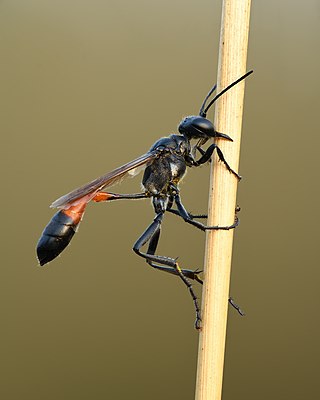
The Sphecidae are a cosmopolitan family of wasps of the suborder Apocrita that includes sand wasps, mud daubers, and other thread-waisted wasps.
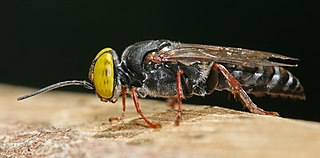
The Crabronidae are a large paraphyletic group of wasps, including nearly all of the species formerly comprising the now-defunct superfamily Sphecoidea. It collectively includes well over 200 genera, containing well over 9000 species. Crabronids were originally a part of the Sphecidae, but the latter name is now restricted to a separate family based on what was once the subfamily Sphecinae. Several of the subfamilies of the Crabronidae are often treated as families in their own right, as is true of the most recent phylogenies.

The Spheciformes is a paraphyletic assemblage of insect families which collectively comprise the "sphecoid wasps". Larvae are carnivorous.

Aculeata is a subclade of Hymenoptera containing ants, bees, and stinging wasps. The name is a reference to the defining feature of the group, which is the modification of the ovipositor into a stinger. However, many members of the group cannot sting, either retaining the ovipositor, or having lost it altogether. A large part of the clade is parasitic.
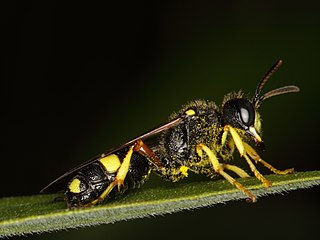
Cerceris is a genus of wasps in the family Philanthidae. It is the largest genus in the family, with 876 described species and 169 subspecies. The genus has a cosmopolitan distribution, with species on every continent.
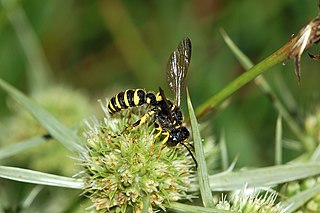
Philanthidae is one of the largest families of wasp in the superfamily Apoidea, with 1167 species in 8 genera, most of which are Cerceris.
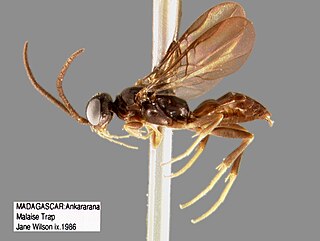
Heterogynaidae is a minor and disputed lineage of small spheciform wasps occurring in Madagascar, Botswana, Turkmenistan, Oman, the United Arab Emirates, and the Eastern Mediterranean area. The majority are dark in color and range in size from approximately 1.5 to 5.0 mm. Most specimens have been collected in arid climates, but one species from Madagascar is known to occur in a humid forest habitat. Although males have functional wings, heterogynaid females are typically brachypterous, a trait which is unique among spheciform wasps. Wing venation is reduced in both sexes. All species are diurnal, with the exception of H. nocticola. Other aspects of their biology are completely unknown, but details of their morphology have prompted researchers to hypothesize that they may be non-fossorial parasitoids adapted to hunt in tight spaces, such as under tree bark. This is speculative and has not yet been confirmed by actual observations of behavior. It is also possible that modifications of the female metasomal tergum VI and gonostyli may represent a unique prey transport mechanism, but this is also unconfirmed.
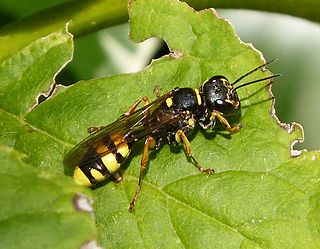
Mellinidae is a small family of wasps, comprising 17 described species in two genera. This group has traditionally been treated as a subfamily within Crabronidae (Mellininae), but recent phylogenomic studies have shown it to be a distinct family.
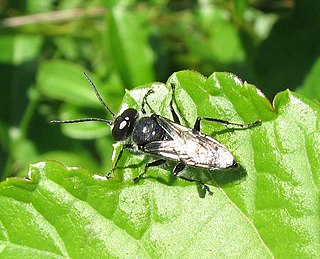
Astata is a cosmopolitan genus of solitary predatory wasps in the family Astatidae. They are known to prey on adults and nymphs of Pentatomidae. Astata is the largest genus in this subfamily, and is identified by features of its wing venation. The males of this genus and the related genus Dryudella have very large compound eyes that broadly meet at the top of the head.
Psen monticola is a species of aphid wasp in the family Psenidae. It is found in North America.

Psen erythropoda is a species of aphid wasp in the family Psenidae. It is found in North America.
Astata occidentalis is a species of wasp in the family Astatidae. It is found in Central America and North America.
Passaloecus cuspidatus is a species of aphid wasp in the family Pemphredonidae. It is found in North America.

Psenidae is a family of aphid wasps in the superfamily Apoidea formerly treated as the tribe Psenini. There are 12 genera and at least 485 described species of Psenidae.
Astata unicolor is a species of wasp in the family Astatidae. It is found in Central America and North America.

Cerceris clypeata is a species of weevil wasp in the family Philanthidae. It is found in North America.
Aphilanthopini is a tribe of wasps in the family Philanthidae. There are two genera and 13 described species are in the Aphilanthopini.

Cercerini is a tribe of wasps in the family Philanthidae. There are 2 genera and 937 described species in Cercerini. About 896 of these species are in the large genus Cerceris.
Cerceris yuwanensis is a species of wasp in the family Philanthidae that is found in Japan.


















